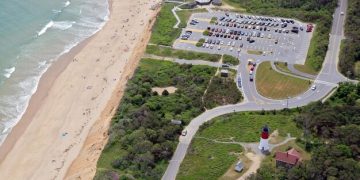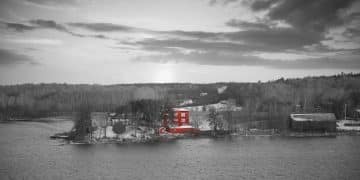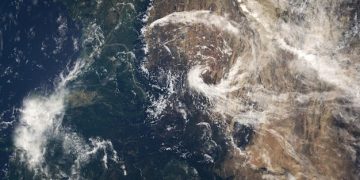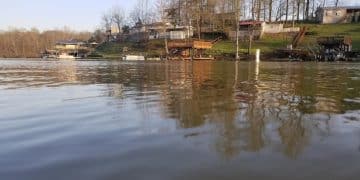Coastal Erosion: New Federal Funding Set to Protect US Coastlines
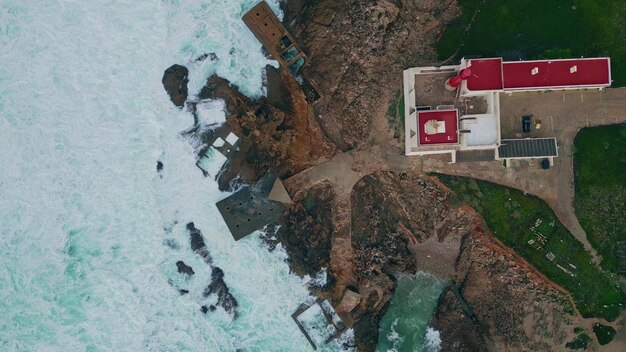
Coastal erosion is accelerating across the US, threatening communities and ecosystems, but new federal funding aims to bolster protection efforts through infrastructure improvements, research, and community engagement programs.
The relentless advance of the sea is reshaping America’s coastlines, with coastal erosion accelerating at an alarming rate. Homes are being swallowed, critical infrastructure is threatened, and cherished ecosystems are vanishing. But there’s a glimmer of hope on the horizon.
Understanding the Crisis: The Accelerating Pace of Coastal Erosion
Coastal erosion, a natural process, is now intensified by climate change. Rising sea levels, stronger storms, and altered weather patterns are all contributing to the rapid loss of our shorelines. This is not just an environmental issue; it’s an economic and social one too.
Coastal erosion impacts communities, economies, and ecosystems, making it a multifaceted challenge that requires comprehensive solutions. Let’s delve deeper into the factors contributing to it.
Factors Contributing to Accelerated Erosion
Several factors are working in concert to accelerate coastal erosion.
- Rising sea levels: As global temperatures increase, glaciers and ice sheets melt, causing sea levels to rise and inundate low-lying coastal areas.
- Increased storm intensity: Climate change is leading to more frequent and intense storms, which generate powerful waves that erode beaches and dunes.
- Human activities: Coastal development, dredging, and the construction of seawalls can disrupt natural sediment transport processes, exacerbating erosion.
Erosion is a natural process, but human activity has accelerated its impact. Areas that were once stable are now disappearing at unsustainable rates.
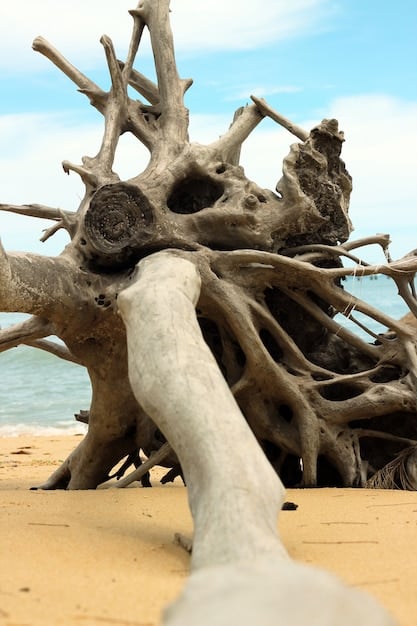
Coastal erosion is not just a concern for beachfront property owners; it has far-reaching consequences for entire communities and ecosystems. Finding sustainable solutions is paramount to preserving our nation’s coastlines.
The Economic Impact: Assessing the Costs of Inaction
The economic costs of coastal erosion are staggering, impacting property values, tourism, and infrastructure. Failure to address this issue will result in even greater financial burdens in the future.
The economic implications of coastal erosion extend beyond the immediate loss of property. The broader impact on coastal economies is substantial.
Quantifying the Economic Losses
The financial losses due to coastal erosion are multifaceted and affect various sectors.
- Property devaluation: Homes and businesses located near eroding shorelines experience significant declines in property value.
- Tourism decline: Eroded beaches and damaged coastal infrastructure deter tourists, leading to decreased revenue for local businesses.
- Infrastructure damage: Roads, bridges, and other critical infrastructure are vulnerable to erosion, requiring costly repairs or relocation.
The economic burden of coastal erosion falls on homeowners, businesses, and taxpayers alike. Investing in proactive measures to protect coastlines is a cost-effective strategy in the long run.
The increasing burden requires communities and government to prioritize investment in coastal defense measures that can protect economies and residents.
Federal Funding to the Rescue: Details of the New Initiatives
The federal government has recognized the urgency of the coastal erosion crisis and is allocating significant funding to support protection efforts. These initiatives encompass a range of strategies, from infrastructure improvements to scientific research.
This new funding represents a significant step forward in addressing the coastal erosion crisis. But how exactly will this funding be used?
Key Components of the Federal Funding Package
The federal funding package includes several key components designed to address coastal erosion from multiple angles.
- Infrastructure improvements: Construction of seawalls, dune restoration projects, and beach nourishment programs.
- Scientific research: Funding for studies to better understand the causes and impacts of coastal erosion, and to develop more effective protection strategies.
- Community engagement: Grants to support local communities in developing and implementing coastal resilience plans.
The federal funding package is designed to be flexible, allowing communities to tailor their protection efforts to their specific needs and circumstances. This comprehensive approach ensures that a wide range of coastal challenges are addressed.
Effective implementation and collaboration between federal, state, and local entities are paramount to protect coastal communities from the impacts of coastal erosion.
Infrastructure Improvements: Hard and Soft Engineering Solutions
Protecting coastlines from erosion often involves a combination of hard and soft engineering solutions. Hard engineering includes structures like seawalls and groins, while soft engineering focuses on natural processes like dune restoration and beach nourishment.
Hard and soft engineering solutions both have their place in coastal protection strategies. Understanding the benefits and drawbacks of each approach is crucial for making informed decisions.

Implementing Effective Solutions
Both approaches play an important role in protecting our coastlines, so which should you choose?
- Seawalls: Provide a physical barrier against waves, but can be expensive and may disrupt natural sediment transport.
- Dune restoration: Creates a natural buffer against storm surges, while providing habitat for wildlife.
- Beach nourishment: Replenishes eroded beaches with sand, but requires ongoing maintenance.
The best approach often involves a combination of hard and soft engineering techniques, tailored to the specific characteristics of the coastline and the needs of the community. Integrating these different approaches can offer the best possible protection while minimizing environmental impacts.
Ongoing monitoring and adaptive management are essential to ensure the long-term effectiveness of coastal protection measures. Careful planning and community collaboration are crucial to choosing these.
Community Engagement: Empowering Local Action
Coastal erosion is a local issue with national implications. Engaging local communities in the development and implementation of protection strategies is essential for ensuring long-term success.
Community engagement is a cornerstone of effective coastal management. Local residents have a deep understanding of their coastlines and are best positioned to identify vulnerabilities and develop appropriate solutions.
The Role of Local Communities
Engaging local communities is paramount to implementing effective solutions.
- Developing resilience plans: Local communities can work together to identify vulnerabilities and develop strategies to mitigate the impacts of coastal erosion.
- Monitoring coastal changes: Community members can participate in monitoring programs, collecting data on beach erosion rates and storm impacts.
- Advocating for funding: Local communities can advocate for federal and state funding to support coastal protection projects.
Empowering local communities to take action is essential for creating a more resilient and sustainable coastline. Their participation ensures that protection efforts are tailored to their specific needs and priorities.
Long-term success of coastal protection efforts relies on establishing partnerships between community members, scientists, and government agencies.
Looking Ahead: The Future of US Coastlines
Coastal erosion is a pressing challenge that requires a concerted effort from all levels of government, as well as the active participation of local communities. The new federal funding provides a critical lifeline, but it’s just the first step in a long-term effort to protect our nation’s coastlines.
The future of US coastlines depends on our ability to adapt to the challenges posed by climate change and coastal erosion. Embracing innovation, collaboration, and community engagement will be essential for ensuring a sustainable future for our coastal communities.
| Key Point | Brief Description |
|---|---|
| 🌊 Accelerated Erosion | Climate change intensifies coastal erosion rates. |
| 💰 Federal Funding | New initiatives support coastal protection efforts. |
| 🛡️ Infrastructure | Engineering solutions protect vulnerable shorelines. |
| 🤝 Community Action | Local involvement is essential for resilience. |
FAQ
▼
Climate change is a major factor. Rising sea levels, stronger storms, and altered weather patterns are all contributing to the rapid loss of shorelines along US coasts.
▼
The funding will support infrastructure improvements like seawalls and dune restoration, scientific research to understand erosion, and community engagement programs to develop resilience plans.
▼
Hard engineering solutions include structures like seawalls and groins, which provide a physical barrier against waves. They are often expensive and may disrupt natural sediment processes.
▼
Soft engineering focuses on natural processes like dune restoration and beach nourishment. These solutions create natural buffers against storm surges and provide habitat for wildlife.
▼
Engaging local communities ensures that protection efforts are tailored to their specific needs and priorities. It also empowers residents to participate in monitoring and advocating for funding.
Conclusion
The accelerating coastal erosion in the U.S. poses a significant threat, but the new federal funding offers a crucial opportunity to implement effective solutions. By combining infrastructure improvements, scientific research, and community engagement, we can protect our coastlines. Continued monitoring, adaptive management, and collaborative partnerships are essential to safeguard these vital areas for future generations.
